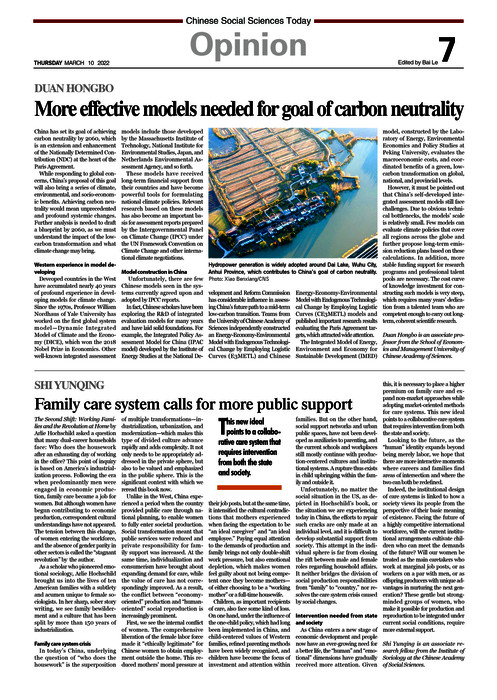Family care system calls for more public support
2022-03-10 14:46:50
The Second Shift: Working Families and the Revolution at Home by Arlie Hochschild asked a question that many dual-career households face: Who does the housework after an exhausting day of working in the office□ This point of inquiry is based on America’s industrialization process. Following the era when predominantly men were engaged in economic production, family care became a job for women. But although women have begun contributing to economic production, correspondent cultural understandings have not appeared. The tension between this change, of women entering the workforce, and the absence of gender parity in other sectors is called the “stagnant revolution” by the author.
As a scholar who pioneered emotional sociology, Arlie Hochschild brought us into the lives of ten American families with a subtlety and acumen unique to female sociologists. In her sharp, sober story writing, we see family bewilderment and a culture that has been split by more than 150 years of industrialization.
Family care system crisis
In today’s China, underlying the question of “who does the housework” is the superposition of multiple transformations—industrialization, urbanization, and modernization—which makes this type of divided culture advance rapidly and adds complexity. It not only needs to be appropriately addressed in the private sphere, but also to be valued and emphasized in the public sphere. This is the significant context with which we reread this book now.
Unlike in the West, China experienced a period when the country provided public care through national planning, to enable women to fully enter societal production. Social transformation meant that public services were reduced and private responsibility for family support was increased. At the same time, individualization and consumerism have brought about expanding demand for care, while the value of care has not correspondingly improved. As a result, the conflict between “economy-oriented” production and “human-oriented” social reproduction is increasingly prominent.
First, we see the internal conflict of women. The comprehensive liberation of the female labor force made it “ethically legitimate” for Chinese women to obtain employment outside the home. This reduced mothers’ moral pressure at their job posts, but at the same time, it intensified the cultural contradictions that mothers experienced when facing the expectation to be “an ideal caregiver” and “an ideal employee.” Paying equal attention to the demands of production and family brings not only double-shift work pressure, but also emotional depletion, which makes women feel guilty about not being competent once they become mothers—of either choosing to be a “working mother” or a full-time housewife.
Children, as important recipients of care, also face some kind of loss. On one hand, under the influence of the one-child policy, which had long been implemented in China, and child-centered values of Western families, refined parenting methods have been widely recognized, and children have become the focus of investment and attention within families. But on the other hand, social support networks and urban public spaces, have not been developed as auxiliaries to parenting, and the current schools and workplaces still mostly continue with production-centered cultures and institutional systems. A rupture thus exists in child upbringing within the family and outside it.
Unfortunately, no matter the social situation in the US, as depicted in Hochschild’s book, or the situation we are experiencing today in China, the efforts to repair such cracks are only made at an individual level, and it is difficult to develop substantial support from society. This attempt in the individual sphere is far from closing the rift between male and female roles regarding household affairs. It neither bridges the division of social production responsibilities from “family” to “country,” nor resolves the care system crisis caused by social changes.
Intervention needed from state and society
As China enters a new stage of economic development and people now have an ever-growing need for a better life, the “human” and “emotional” dimensions have gradually received more attention. Given this, it is necessary to place a higher premium on family care and expand non-market approaches while adopting market-oriented methods for care systems. This new ideal points to a collaborative care system that requires intervention from both the state and society.
Looking to the future, as the “human” identity expands beyond being merely labor, we hope that there are more interactive moments where careers and families find areas of intersection and where the two can both be redefined.
Indeed, the institutional design of care systems is linked to how a society views its people from the perspective of their basic meaning of existence. Facing the future of a highly competitive international workforce, will the current institutional arrangements cultivate children who can meet the demands of the future□ Will our women be treated as the main caretakers who work at marginal job posts, or as workers on a par with men, or as offspring producers with unique advantages in nurturing the next generation□ These gentle but strong-minded groups of women, who make it possible for production and reproduction to be integrated under current social conditions, require more external support.
Shi Yunqing is an associate research fellow from the Institute of Sociology at the Chinese Academy of Social Sciences.


